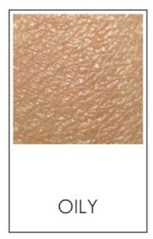how to figure out your skin type | skincare 101
There are five main different categories of skin type: Dry, Normal, Oily, Combination, and Sensitive. In this post, you'll get a quick overview of each type so you can determine what skin type you have! This first step in crafting your perfect skincare routine is crucial, because everyone's skin has different needs.
DRY
Dry skin types are obviously dry. However, depending on your skin and environmental factors, dry skin may be 'fixed'. In some cases, dry skin is a result from over-washing, cold weather, or improper skincare practices. Other times, the skin's moisture barrier simply doesn't retain enough moisture.
Dry skin is characterized by roughness, cracking, and flaking. Redness, itching, and even bleeding can occur, although dry skin typically has smaller pores and fewer cases of acne!
NORMAL
Considered the Unicorn skin type, 'Normal' is what dermatologists deem to be the ideal skin type. It's neither too oily or dry, meaning the skin barrier retains the right amount of moisture while protecting against external factors, making Normal skin the easiest to care for.
Typically, those with the Normal skin type have fine pores, few blemishes and breakouts, even skin tone, and a supple texture. Depending on your activities and weather conditions, your skin may be oilier or drier some days; although generally, moisture levels don't fluctuate too much.
OILY
Oily skin types are usually a result of genetics. Characterized by greasier than normal skin, the oily skin type produces too much sebum, which is produced by overactive sebaceous glands. Sebum is basically the skin's natural oil, which can be great in ideal amounts!
However, oily skin types produce too much sebum, resulting in larger pores that can lead out to frequent break outs of whiteheads, acne, and blackheads. Your skin may have a greasy feel and may not easily take on make up.
COMBINATION
As the name suggests, combination skin is a combo of two skin types: dry and oily. Typically, those with combination skin experience oily skin in their T-zone, the forehead, nose, and chin area, while the cheeks are categorized as dry skin. This is because the T-zone has a higher concentration of oil glands.
Combination skin is one of the most common skin types. Those who have combination skin may have dry flakiness on their cheeks while still having breakouts.
SENSITIVE
Sensitive skin type may be a result of a variety of factors, such as an impaired skin barrier, extreme dryness, using specific skin products, and more. Certain skin conditions may occur, and irritation is more often and extreme in those with sensitive skin.
Those with oily, dry, or normal based skin may develop sensitive skin types. Side effects are typically redness, itchiness, or burning that may be easily triggered especially when using new skin products. Compared to dry skin, these conditions occur more frequently and may be more irritating.
Now that you've read over the basic descriptions of the five main skin types, you should have a better idea of what your skin type is! Know that your skin is unique, so it may not necessarily have all the characteristics listed above. These five categories are just meant to give you a better understanding of your skin and how to craft a skincare routine based on your skin needs. If you need help with figuring out what skin type you have, check out the quick tests you can do on your own below!
METHOD 1: Wash your face and use your current cleanser to thoroughly go over all of your skin. Then, pat dry with a towel and wait an hour. Finally, use some tissue paper / toilet paper to dab at your T-zone.
Dry - Your paper comes out dry, and additionally, your cheeks are dry and parts of your skin may feel flaky and look slightly red
Normal - Your paper comes out dry, and you skin doesn't feel dry or tight
Oily - Your paper comes out greasy, and your skin doesn't have signs of flakiness or tightness
Combination - Your paper comes out greasy, and your cheeks are dry and have signs of flakiness and/or tightness
Sensitive - Your paper comes out dry, although some greasiness may also be present, and your skin feels irritated, red, or burned.
METHOD 2: Observe your skin at the end of the day, from morning to night.
Dry - Your face looks and/or feels flakey, dry, and tight.
Normal - Your face looks and/or feels minimally oily and dry
Oily - Your face looks and/or feels greasy and shiny
Combination - Your T-zone looks and/or feels oily and shiny while the rest of your face may be dry and flakey
Sensitive - Your face looks and/or feels itchy, red, and inflamed.
Up next in the SKINCARE 101 series are in-depth info sheets on how to create a skincare routine customized to your specific skin type. Each post will feature one of the five main skin types you read today and help you understand what your skin needs are!









Comments
Post a Comment